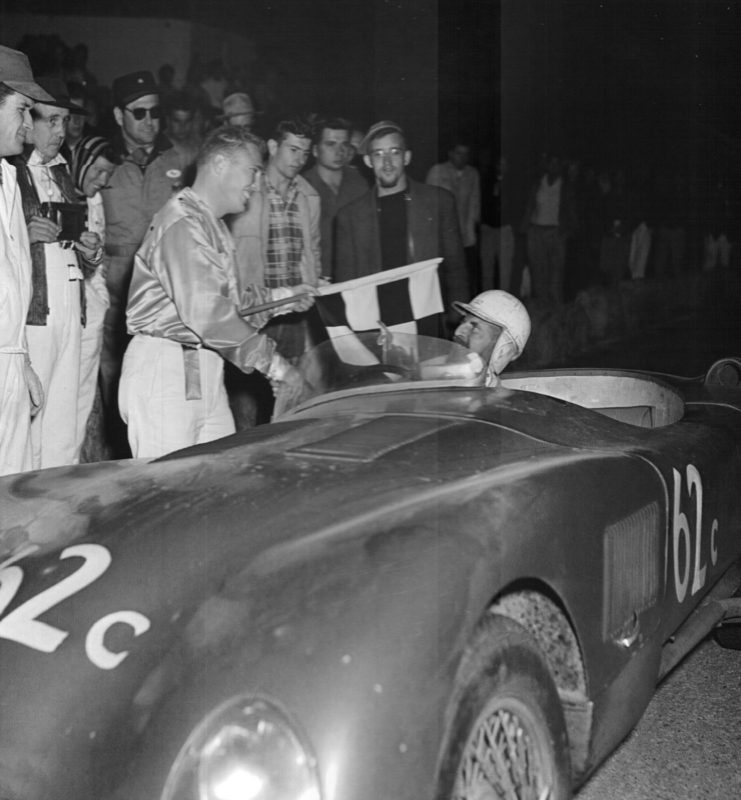Notes From The Archives: JAGUAR C-TYPE
December 14, 2017JAGUAR C-TYPE
Words by: Gary Horstkorta
You have not doubt heard the Enzo Ferrari proclaimed after the introduction of the Jaguar E Type as the most beautiful car design he had ever seen and rightfully so. Even today the E Type is still a beautiful car to behold. As wonderful a design as the E Type was (is) it came from good bloodlines including a car with simple, flowing lines which helped it become one of Jaguar’s most famous race cars – the C-type.
Prior to the C -type, Jaguar had already gained notoriety when the entered three factory cars for the 1950 Le Mans 24 Hours race. Two of the cars finished 12th and 15th, a respectable finish for the relatively new XK-120. As sports car racing began to find its footing in the U.S., the Jaguar XK-120 was the car of choice for many racers that could afford one. Not only were they fast but also quite reliable. Several 120s appeared in local races driven by Phil Hill, Sam Weiss, Bill Breeze and Ray Seher.

Eventual winner Gregory spun during the 1953 Golden Gate Park race.
After the relative success of the 120 in the 1950 Le Mans race, Jaguar decided to move ahead with a redesigned car with a more aerodynamic body but using the 120 mechanicals. This new, shapely design was called the XK-120 C or C-type for competition. Hoping to enter the cars in the 1951 Le Mans race, three C-types were hand built in just six weeks, finished just in time for the event. While two of the cars retired, the third car won the race over the second place car with a margin of 77 miles.
The C-types greatest success came at the 1953 Le Mans 24 Hours. The cars came to Le Mans sporting two major changes that played a large part in the race results – all four factory cars were equipped with disc brakes and triple Weber Carburetors. Three of the four cars finished placing first, second and fourth, a convincing victory for Jaguar and the C-type.

Ray Seher driving the ex- Edwards, Brero C-type at Arcata in 1956.
The Le Mans victory did not go unnoticed in the U.S. as orders for C-types began arriving at the Jaguar Importers in New York (Max Hoffman) and Los Angeles (Charles Hornburg). The first C-type and the seventh one built was purchased by Hornburg who enlisted Phil Hill to race the car in several events to help promote sales. Hill did a good job by finishing fourth at Elkhart Lake, first at Watkins Glen, second at Madera Airport and first at Torrey Pines. The car was then sold to Cal Club racer Carlyle Blackwell who raced it 1955-57 before selling it on to a Robert Lane. Lane took the car to Bonneville in 1957 where he reached a top speed of 157 mph. Since then the car has passed through several owners, appeared at the Amelia Island and Pebble Beach Concours and is currently in a private collection.
Only fifty-four C-types were built from 1950 through 1953 with eleven being shipped to Charles Hornburg on the west coast and of those seven, five competed in SFR events. Sterling Edwards bought the first C-type in the area and entered it at the 1953 Pebble Beach race but his mechanic, Phil Remington (yes, THAT Phil Remington) crashed the car during a practice run. Undaunted Edwards immediately approached another SFR race, Al Coppel, and bought his new C-type on the spot then finished fifth in the feature race.

Sterling Edwards in his C-type before the practice crash at Pebble Beach in 1953.
Edwards original C-type was repaired and sold to rising star, Lou Brero who raced it through the balance of the 1953 and the full 1954 seasons. He then sold the car to Reno, Nevada resident Ray Seher who raced it for two full seasons, 1955-56 doing very will with many podium finishes. The car then passed through several owners, all of which raced it right up until 1970 when it was retired to storage. In 1987 it was acquired by Jaguar restorer Terry Larsen who has raced it in over 100 vintage events.

Lou Brero winning the six hour endure at Torrey Pines in the ex-Edwards C-type.
In 1954, the C-type gave way to the next iteration of Jaguar race cars, the D-type. Using the same basic mechanicals as the C-type but with an improved chassis and more aerodynamic body, the D-type was a much faster race car. It’s exploits at Le Mans are well know and continued on the winning tradition established by the XK-120 and the C-type.

